Design for Adaptive Innovation: Strategizing at Speed
Successful market innovation in the 21st century requires more than just a new product, offering, or business model


The emerging economies of China, India, Latin America, and Africa contain some of the fastest moving markets in the world. To survive in these dynamic markets, successful companies have modified their innovation cycles to provide meaningful products more rapidly than ever before. Take the phenomenal growth of Sina Weibo, a Chinese social media company launched in 2009. Originally a Twitter ‘copycat’, today Weibo is a hybrid media company with 300 million users sending an average 86 million messages a day.
How did Weibo catapult itself to success? By launching to learn in an emerging market and iterating products based on real-time feedback. For large, well-established companies, sometimes not adopting an iterative approach to innovation can lead to costly mistakes.
Take Nokia, for example -- once the global leader in feature phones. With such great power and size, the company should have been in a perfect position to retain global market leadership with the launch of a new version of the Symbian OS. Instead, Nokia perfected a phone for a market that had already vanished—and initially missed the revolutionary shift from voice/SMS to smart phones. Meanwhile, Samsung rapidly evolved and delivered its Galaxy line of smartphones, despite being no better set up for success. In 2012, Samsung controlled 25 per cent of the smartphone market in China alone.
Tales of falling titans are increasingly common in disrupted industries. Borders Books, once the second largest U.S. chain, filed for bankruptcy in 2011, and Blockbuster Video, the movie rental giant, succumbed to its rivals in 2010. The old days of seeing a threat on the horizon and being able to prepare a response are gone. The real shocker is that this rate of change is not linear, but exponentially increasing: the inventor and futurist Ray Kurzweil predicts even more radical industry shifts by 2045.
The fact is, successful market innovation in the 21st century requires more than just a new product, offering, or business model. It calls for a new organizational approach to change: Design for Adaptive Innovation.
At IDEO, some designers refer to this as ‘the squiggle’.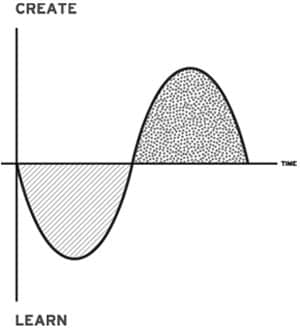
Design for Adaptive Innovation is a cycle of discovery that alternates between learning and creating. Traditionally, innovation undergoes one of these cycles during a project—Research, Synthesis, Design. A single up-and-down cycle is a ‘unit’ of design that represents the process of learning, getting inspiration from the world, extracting possible meanings from that inspiration, and creating ways to address design opportunities.
Design for Adaptive Innovation is a new approach to building businesses that can deal with rapidly changing and complex markets. The approach incorporates four pillars of success: Purpose, Pace, Pulse, and Prototyping, which are explained below. In practice, this means removing extraneous steps in the corporate R&D process and strategizing in two modes: learning and creating.
Large, traditional organizations may spend up to a year in learning and research before moving on to prototyping and creating products, during which time a consumer’s habits and tastes may have changed dramatically. Small startups often prefer to operate concurrently in both learning and creating modes, which works well for some organizations, but not all. For numbers-driven management teams seeking a bridge between the two extremes, Adaptive Innovation offers a way to rapidly alternate between the modes of learning and creating, allowing a market-tested strategy and offering to evolve from the fog of the unknown. Multiple cycles of adaptive innovation design enable companies to successfully mitigate risk, without killing off fledgling ideas.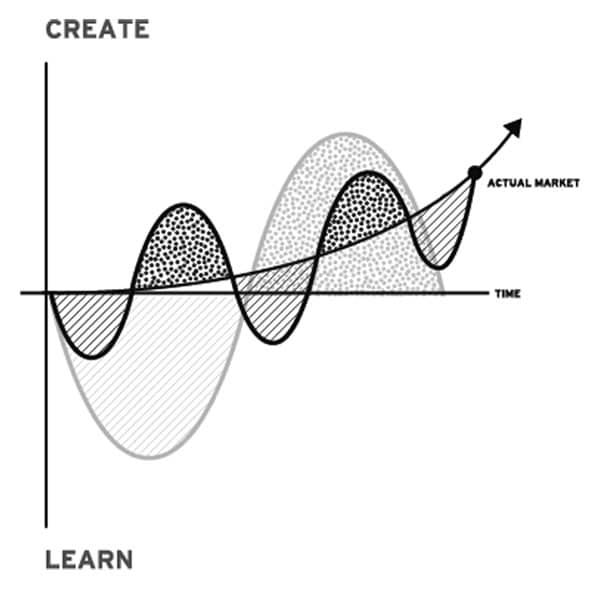 By becoming fast and flexible, next-gen corporations can evolve offerings that lead market change.
By becoming fast and flexible, next-gen corporations can evolve offerings that lead market change.
Adaptive Innovation also enables designers to rapidly integrate thin-sliced information from in-market testing to create and test meaningful prototypes that lower overall corporate risk. Through rapid cycles of learning and creating, organizations can then evolve a solution even as they change direction many times.
Let’s take a closer look at each of the four pillars of the Design for Adaptive Innovation approach: Purpose, Pace, Pulse, and Prototyping.
1. Purpose
“We’re here to put a dent in the universe.” – STEVE JOBS  Every successful startup has a purpose -- a change in the world it wants to make through its offering. Apple at its launch was no exception. From the ‘Lisa’ computer to the latest iPad, the company’s desire to create “insanely great” products has shaped new markets. As Apple’s success demonstrates, a strong purpose allows a company to filter new opportunities and leverage changing market conditions over time to productively disrupt itself before competitors do.
Every successful startup has a purpose -- a change in the world it wants to make through its offering. Apple at its launch was no exception. From the ‘Lisa’ computer to the latest iPad, the company’s desire to create “insanely great” products has shaped new markets. As Apple’s success demonstrates, a strong purpose allows a company to filter new opportunities and leverage changing market conditions over time to productively disrupt itself before competitors do.
Clear purpose simplifies decisions about what to ‘create,’ and helps define criteria and metrics to observe and measure when in the ‘learn’ loop. But as companies grow, it becomes harder to retain that clarity. Sometimes a clarification is needed, involving a return to the core values on which the company was founded. Some large companies, like GE, have successfully shed irrelevant business units in order to recover and communicate their purpose.
Often, social good is interwoven with corporate purpose, as exemplified by Patagonia. Founder Yvon Chouinard was a rock climber who built the company in the 1970’s out of a garage in Ventura, CA in order to make quality, eco-friendly gear available. Decades later, the company’s choices continue to reflect a strong commitment to the environment and a love of “wild and beautiful places.”
Importantly, a purpose is different than a goal. A goal-driven team has an implicit assumption that their goal is the right answer. In the unknown waters of innovation at speed, this can be a fatal assumption
The Question to Ask Yourself: In one sentence, what is the change your company is trying to create for your customers? Is this a clear and incentivized purpose that unites employees across all parts of your organization?
2. Pace
“Everyone has a plan, ‘till they get punched in the mouth.” —MIKE TYSON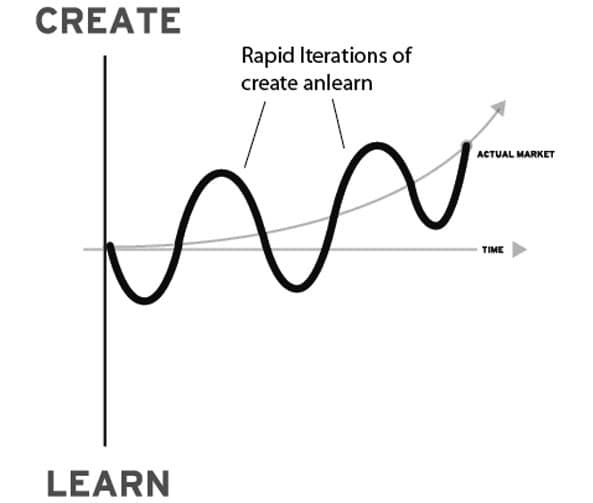 There is an old saying in mountaineering that has saved countless lives: “Speed is safety.” The faster up a mountain and back down, the less chance a climber has of getting hit by lightning, falling rocks, or anything else trying to kill them in the high lonesome.
There is an old saying in mountaineering that has saved countless lives: “Speed is safety.” The faster up a mountain and back down, the less chance a climber has of getting hit by lightning, falling rocks, or anything else trying to kill them in the high lonesome.
It is much the same in fast markets. By moving quickly, companies can micro-chunk risk to limit overall exposure and eliminate costly inefficiencies. Design at a faster pace reduces financial risk.
When it comes to innovating at a fast pace, the smartphone fight in China offers useful examples. With giants Apple, Samsung, and Huawei battling for supremacy in the multi-billion dollar market, can a smaller company also succeed? It’s hard to say, but Xiaomi (Little Rice) is rapidly trying to find out. In 2011, Xiaomi launched a smartphone featuring its own operating system at half the cost of the iPhone. With hardware locked to known constraints, rapid software iteration became the development team’s focus. Rapid innovation has led to lower risk and bigger wins for the company: Xiaomi has sold over two million phones since launch.
The Question to Ask Yourself: What is the pace of your organization’s research and development cycle? How many handoffs does it take to launch an idea? Do you have teams that are empowered to work rapidly and launch market experiments?
3. Pulse of the market
“We evolve genres by making games free, social, accessible, and of the highest quality.”—MARK PINCUS
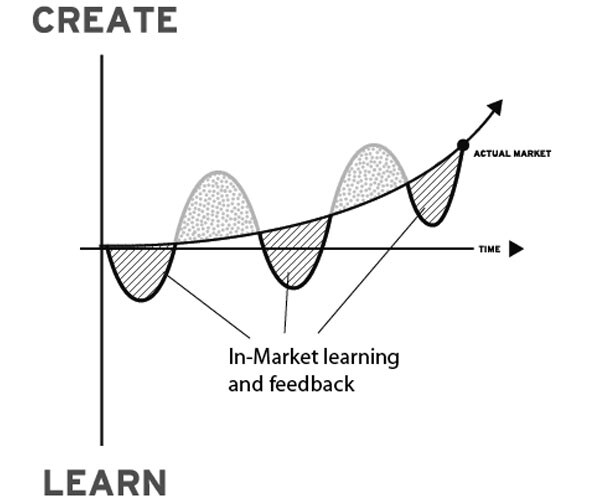
Silicon Valley-based social gaming companies are renowned for their ability to continually take the pulse of the market—and then rapidly launch innovations that change the market over time. One way these companies do this is by launching multiple versions of a game with different feature sets and then tracking player engagement. Based on in-market testing results, leaders then adapt the most desirable features for wider release. Such real-time research and development means that popular games can evolve to maturity within weeks.
Across the Pacific, G’Five is a mobile phone manufacturer that regularly takes the pulse of the Indian market, producing small runs of 5000 phones that contain a new feature in addition to a regular run. By measuring the sales velocity of the experimental run relative to the regular run, G’Five is able to determine which mixture of price and features will work best at that moment. Adaptive innovations like these have helped the company turn a low-margin business into the sixth-largest phone provider in India, gaining market share in the country at a much faster rate than mature brands like Nokia and Sony Ericsson.
In large companies, it is common practice to use quantitative surveys and focus groups to validate innovation, especially in latter stages of development. Adaptive Innovation design cycles can reduce the need for a binary go/no-go decision and enable smart companies to slowly build or align the market with their innovation. On the tactical level, there are a number of techniques that enable companies to execute an adaptive approach to testing the pulse of the market—from Minimum Viable Product launches, to A/B testing, to pop-up shops, limited pilots, and digital testing via social channels. By listening to the market while evolving ideas, relevant innovations can then move quickly.
The Questions to Ask Yourself: Is your organization organized into silos of market insights and product development? Are your product teams keeping a pulse on the market, or are you outsourcing this to third party research firms?
4. Prototyping
“Practicing is better than knowing” —XUN ZI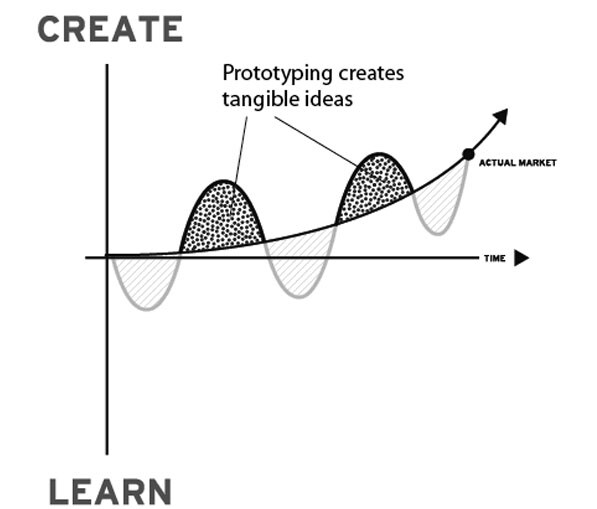 Overly-abstract thinking can create costly failures. Some companies stay abstract for too long in their innovation process, creating spreadsheet after spreadsheet to support further research when quick and dirty prototyping would allow for smart decisions to be made quickly.
Overly-abstract thinking can create costly failures. Some companies stay abstract for too long in their innovation process, creating spreadsheet after spreadsheet to support further research when quick and dirty prototyping would allow for smart decisions to be made quickly.
During prototyping, it can be useful to pursue multiple solutions simultaneously and see which ones emerge as winners. One Chinese business that has used this tactic successfully is One the Store. A digital store that provides one-stop shopping for Chinese consumers, it is one of the fastest growing companies in China, having ballooned in three years from 4 Million RMB to 3 Billion RMB. At launch, the company deliberately pursued an extremely flexible business strategy, employing multiple competing business models at the same time. When two promising business models emerged, One the Store implemented them across the whole enterprise. In Adaptive Innovation, prototyping is not just a phase of innovation, it is the backbone of innovation.
The Questions to Ask Yourself: When was the last time a team was congratulated for taking a controlled risk and failing? Are meeting rooms and project spaces conducive to impromptu physical prototyping?
In closing
In the 21st century, speed is a defining characteristic of emerging markets, and industry innovation cycles must keep pace. Innovation in fast markets is no longer just about the product, offering, or business model, it is about the entire organization. An adaptive approach to business innovation and design is uniquely positioned to provide a crucial bridge between business and design via the rapid creation of prototypes and in-market learning. Through Design for Adaptive Innovation, smart corporations will be better positioned to succeed in fast, blind, and dense 21st century markets.
As a senior designer and part of the Asia leadership team at IDEO, Arvind Gupta works with both startups and large corporations to design standard-setting innovations in emerging markets.
First Published: Jul 12, 2013, 07:06
Subscribe Now